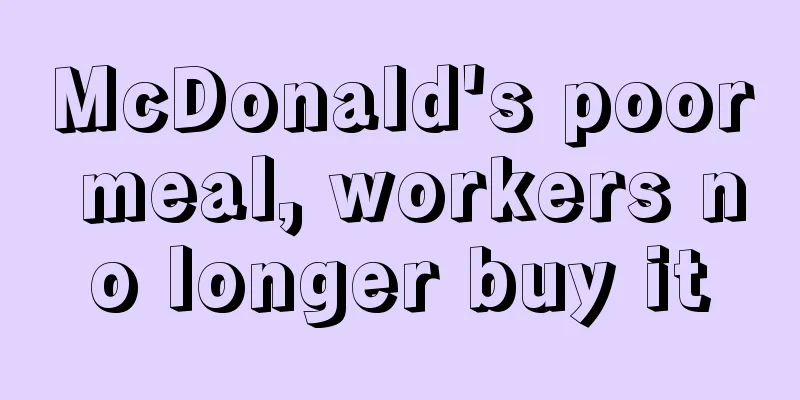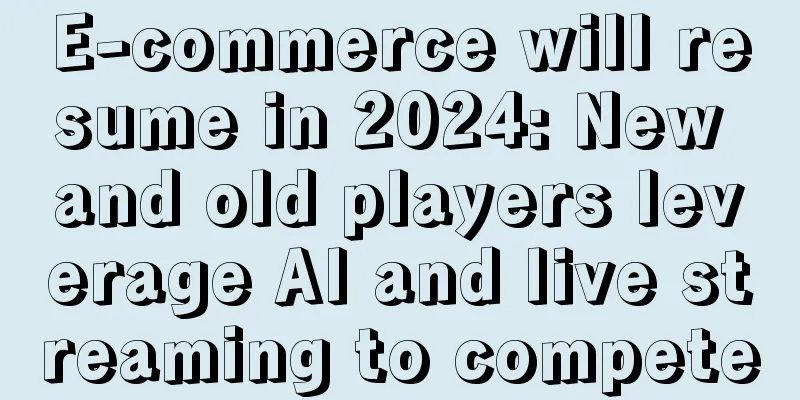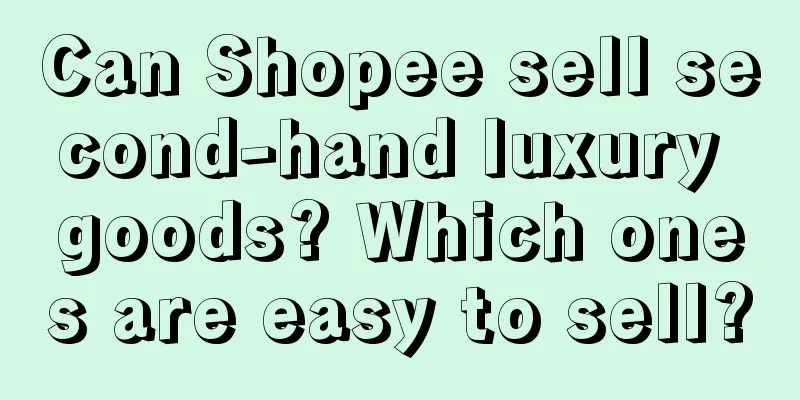McDonald's poor meal, workers no longer buy it

Have you ever thought that one day McDonald's will also worry about its performance? On July 31, McDonald's released its second quarter financial report for fiscal year 2024. The financial report showed that McDonald's revenue this quarter fell 1.8% year-on-year to US$6.49 billion, lower than the expected US$6.61 billion; net profit attributable to the parent company was US$2.022 billion, compared with US$2.31 billion in the same period last year. McDonald's management said they are refocusing on how to attract consumers again through promotions, while working to extend the discount period for the $5 meal. Joe Ellinger, president of McDonald's USA, said that performance in some regions of the United States was "poor" this quarter, with same-store traffic falling for four consecutive quarters and customer orders also decreasing. "We continue to lose low-income consumers," Ellinger said in a memo. Even a strong company like Maimen has begun to waver. We can't help but ask, what are the once most loyal "poor guys" thinking? 01 Low price is not ineffective"Is the poor man's meal not working anymore?" First, let's answer this question. "New Consumption 101" believes that the poor man's package is still effective. It's just that the cake is smaller and the difficulty is greater. On August 2, Burger King China announced that it will launch the "Signature Burger, 9.9 Yuan Every Week" campaign on August 5. Each week, a 9.9 Yuan burger will be the lowest-priced burger product in Burger King's history. Image source: Burger King China official Weibo It must be admitted that as consumers have access to more and more options, McDonald's and KFC have indeed become "less valuable." Nowadays, by opening the food delivery app, we can still buy a good lunch for 20 or 30 yuan, even in first-tier cities like Beijing and Shanghai. Compared with the average customer spending of 40 or 50 yuan in previous years, people's Engel coefficient has indeed dropped a lot. But people's greed is endless. Simply put, if you eat something delicious, you will want to eat something more delicious; if you eat something cheap, you will want to eat something cheaper. As long as there are enough competitors, there will always be someone willing to attract consumers with a more cost-effective price. The poor have not disappeared, and have even become more numerous. However, due to oversupply, the poor have the capital to be picky. "It's not that I don't like McDonald's, I just change it up. For example, I always eat at KFC for Crazy 4, and I can order other takeouts at other times. They are generally cheaper now. I will get tired of eating McDonald's all the time." Peter, who calls himself a financial migrant worker in Lujiazui, said with a smile, "The poor guy is still the poor guy, but now every family can make the poor guy meal." Recently, Morketing founder and CEO Zeng Qiao had an in-depth conversation with McDonald's China Chief Growth Officer He Yabin in the "Ten Years" column. When talking about the changes in the past decade, He Yabin said: "The biggest negative change is that the brand ecological environment has become worse and brand assets have been severely damaged. The marketing feedback loop in the past 10 years does not encourage long-term brand building. Compared with the explosive traffic strategy, the long-term dissemination of brand values appears slow and inefficient. Platforms and ecosystems frequently support the launch of new products and quickly harvest traffic." The only unchanging points seem to be very boring and non-gimmicky things. "Brands still need to have excellent products and excellent packaging. McDonald's has One McDonald's Way of Marketing, which is to provide customers with clean, delicious, freshly made, convenient, fast, and cost-effective products, etc." It can be seen that the brand value point that has not changed for ten years is still highly consistent with the demands of current consumers. The brand has not changed, but the environment has changed. In the United States, McDonald's has launched a $5 meal, including a double cheeseburger or McChicken, fries and a drink. The sales of this meal have reached the expected target, and the store traffic has increased significantly during the promotion period, attracting more diners from competitors. Originally planned to only offer the $5 meal for one month, about 93% of restaurants have promised to extend the sale. Image source: McDonald's official website The Poor Man's Meal is still effective and will continue to be effective. However, with more competitors in the denominator, McDonald's will inevitably get a smaller share even as a strong numerator. As consumers are increasingly unwilling to pay for brand premiums, will the “brand” itself become a burden? “New Consumption 101” believes that it will not. First, the popular white-label products are a major branch of the commodity classification, and this branch has existed for a long time. Just like the corresponding branded chain convenience stores, there will always be mom-and-pop stores. Although the customer groups targeted by both parties overlap, they are still different, and the size is even more different. Secondly, more than 90% of white-label merchants have hidden ambitions. They started out as white-label businesses, but in the future their most important goal will still be to become a brand. The word "McMan" is one of the most typical brand effects. When you want to order a work lunch, at the same price, would you choose McDonald's or an unknown small hamburger shop? It's just that McDonald's in the past could occupy the minds of consumers with relatively high prices, but now, McDonald's can only capture consumers with compressed advantages. Some people may ask, only top brands like McDonald's can demonstrate such brand potential. So for second-tier consumer brands, how should they deal with such a VUCA era? 02 1.5 yuan breakfast businessOn July 30, Tai Er Pickled Fish announced a strategic partnership with Meituan, planning to open 50 "satellite stores" in 2024 and jointly explore innovative marketing models such as "God Membership". The financial report released by Jiu Mao Jiu Group previously showed that it would introduce new business models such as takeaway "satellite stores". By the end of May this year, Tai Er Pickled Cabbage Fish had opened takeaway "satellite stores" in four cities: Guangzhou, Shenzhen, Shanghai and Xiamen. The takeaway "satellite store" is a small store model for convenient takeaway. The store is small and has few people, so it does not provide dine-in services. The products are mainly single-person meals and double-person sets, with fewer SKUs. It not only helps to reduce operating expenses, but also improves the efficiency and production capacity of takeaway services. According to a research report by Huafu Securities, in addition to Tai Er, Haidilao, Lao Xiang Ji, Xiabu Xiabu, etc. have all opened "satellite stores". It is not ruled out that more chain restaurant brands will follow this model soon in the future. The more important strategic value of chain restaurants opening satellite stores is that they facilitate rapid expansion and increase market share. Whether self-operated or franchised, low-cost satellite stores are the most conducive to store expansion. The expansion of branded coffee shops such as Luckin Coffee and Manner is based on a similar model. Large dine-in restaurants build their brands, while small take-out restaurants focus on sales. This new model is expected to become a new trend in the catering industry. Under this trend, large stores will be more like experience stores. The combination of the two models also gives consumers different choices. In addition to changing the store model, are there any other ways for catering companies to increase efficiency? Another group of brands chose to compete in staggered periods, the most obvious of which was that everyone started selling breakfast. In Shanghai, Aldi supermarkets have moved up their opening hours from 8 a.m. to 7 a.m.; Yoshinoya launched a new breakfast product starting at 5.9 yuan at the end of March, with different Chinese breakfasts from pot stickers to wraps to porridge, 7 days a week, and customers can freely combine them. On the streets of Xi'an, Haidilao directly chose to set up stalls to sell breakfast, with an average price as low as 1.5 yuan. If you think about it carefully, can breakfast priced in the single digit really make money? And how much money can it make? This is of course a big question mark. This method of trying to improve the efficiency of square meters has different costs and difficulties for each brand. Take Aldi as an example. It already has a rich variety of fresh food and baked products, which are very suitable for white-collar breakfast business. There is no need to add additional SKUs, and there is no extra cost except for extending the business hours by one hour. From Haidilao's perspective, although the breakfast price as low as 1.5 yuan can become popular in the first place, the profit margin is obviously very thin, and it is difficult to bring about a qualitative improvement in the company's profits. Most non-top-tier catering brands make breakfast for the purpose of relieving anxiety. However, whether anxiety can be relieved still needs to be tailored according to one's own situation in order to be targeted. 03 The Trap of Vicious CompetitionOn one hand, our consumers are intoxicated by the all-out war of 9.9 yuan; on the other hand, catering companies are struggling to survive every day. We can't help but ask: are the consumers wrong? Are the brands wrong? Or have they fallen into some other deeper trap? On July 30, the Political Bureau of the CPC Central Committee held a meeting to analyze and study the current economic situation, deploy economic work in the second half of the year, and review the "Several Provisions on Rectifying Formalism to Reduce Burdens on Grassroots Units." The meeting pointed out the need to strengthen industry self-discipline and prevent "involutionary" vicious competition. Frankly speaking, "involutionary" vicious competition has already appeared in many industries today, and it is more prominent in the consumer industry. Everyone still remembers the 9.9 yuan war in the coffee industry. No coffee company can escape. If you want to continue to survive in this field, you must fight a price war. But except for new brands like Luckin Coffee that need to quickly seize the market, price wars do not do much good for already famous brands. Take consumption as an example. Most brands do not have a strong moat. Under the involution, the only option left is a simple but harmful business war, such as price war. As for Luckin Coffee, how long did it take to reap profits from the price war? In the first quarter of 2022, Luckin Coffee, which was established five years ago, achieved operating profit for the first time. However, more than two months after the release of the 2023 annual report, Luckin Coffee fell into losses again, and showed a clear increase in revenue but not in profit. Under the continuous erosion of price wars, a large number of coffee shops have become cannon fodder, and even big brands or boutique brands like Starbucks have to bow to the market in order to survive. The endless involution in traditional fields will actually make many young people lose their fighting spirit, to the point that "as long as I lie flat enough, nothing can roll me up." In addition to the injuries to the practitioners, this long-term price war has even caused consumers to develop a kind of inertia of thinking: if you don’t buy it and I don’t buy it, the price can be reduced by 300 tomorrow. Let me ask, isn’t this kind of thinking another reflection of quasi-deflation? my country has always been one of the countries with the highest savings rate in the world, which has long remained at around 40%. However, judging from recent trends, the savings rate of young people is significantly insufficient and is declining rapidly. The distortion of consumption structure stems from the change in population structure. Under the aging trend, the proportion of the elderly population is increasing, and there are problems with the income growth rate and expenditure ratio of young people. The vast majority of savings rate contributions come from the elderly, thus forming a fault-type savings structure. If the overall macroeconomic environment enters a low-growth state, the income expectations and wealth effects of the whole society will not be so obvious. Young people want to spend money but have no money to spend, and the elderly have money but do not want to spend it. After the combination of the two, the trend of consumption downgrade is inevitable. This has become a vicious cycle: consumers don't want to spend money, and merchants desperately lower prices; the more merchants lower prices, the less consumers want to spend money. The experience of Japan's low-desire group tells us that under vicious competition, there are actually no winners between merchants and consumers. McDonald's is ready for a protracted war. McDonald's U.S. President Ehlinger expects "industry and competitive challenges" to continue throughout the year. Ehlinger encouraged operators to look to the future and build momentum for next year. He also said: "Developing a long-term mindset is critical to the company's success." 9.9 yuan, this price tag looks very tempting at first glance, but in the long run it will be detrimental to the development of the brand. Consumers will not want to live in a deflationary economic environment for a long time. Changing the consumption pattern is not just the responsibility of a certain brand or industry, but requires the joint efforts of the whole society. The reason we are engaging in a price war now is so that we can stop engaging in price wars in the future. Author: Koala is a Deer |
<<: Douyin’s new e-commerce function also says “no” to low-price competition!
>>: Shared bicycles will continue to rise
Recommend
Marketing strategies of beverage brands
What do you think of when you mention Nongfu Sprin...
Offline explosion: Invest 200 yuan and earn 400,000 yuan
Why are online brands moving offline? The author a...
How much does it cost to build an independent website? How much does it cost?
An independent website is a free website, and the ...
What sites does eBay have? Which eBay site is good for business?
As a member of the cross-border e-commerce platfor...
MINISO, addicted to collaborations, has turned itself into a "toy store"
As the retail industry continues to change, MINISO...
What is the difference between a virtual credit card and a physical credit card? How to apply for one?
In the digital age, the credit card industry has a...
How long does it usually take for Amazon to withdraw cash? What are the withdrawal rules?
Now the prospect of cross-border e-commerce is rea...
How to use shopeeSpayLater? What is the method?
On the Shopee platform, many buyers want to experi...
Can I still work as an Amazon service provider? What should I pay attention to when opening a store?
In fact, opening a store is not the only option fo...
How to efficiently attract users in the infant formula market? Tips on how to effectively create content on Xiaohongshu!
How much do you know about the infant formula mark...
How much commission do new Amazon operators usually get? Is the salary high?
There are still many merchants in China who sell o...
Can Wish deliver goods locally? How does Wish deliver goods?
Some of the merchants who have opened stores on th...
Why can’t the Arctic Ocean be sold for 6 yuan?
Arctic Ocean has been questioned due to its high p...
100 Keyword Predictions for 2023 | Culture (01-10): Vitality, Strength and Excitement
WPP's brand Wunderman Intelligence released it...
New strategy for high customer orders in 2024: Red Book content seeding, private domain service closing
In the new era of digital marketing, how can we ef...









